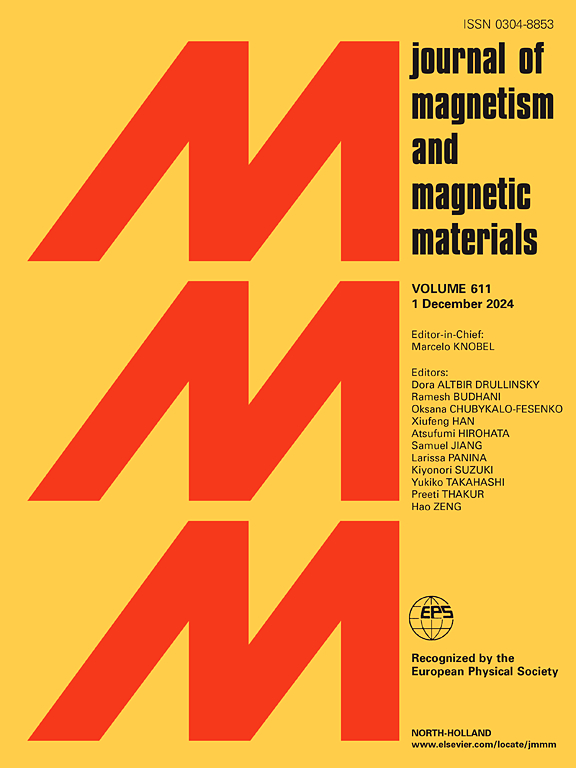Gd11O10(SiO4)(PO4)3磷硅酸盐的结构、磁性和低温磁热性能
IF 2.5
3区 材料科学
Q3 MATERIALS SCIENCE, MULTIDISCIPLINARY
引用次数: 0
摘要
本文通过高温固相反应合成了Gd11O10(SiO4)(PO4)3磷酸硅酸盐,并对其结构、磁性能和低温磁热性能进行了系统的研究。发现Gd11O10(SiO4)(PO4)3呈三斜状结构(空间群P1)结晶,其一致性元素均均匀分布,分别以Gd3+、Si4+、P5+和O2 -价态存在。此外,在3.1 K的磁有序温度附近,观察到突出的磁热学性能。在0 ~ 7t磁场变化条件下,Gd11O10(SiO4)(PO4)3氧化物的最大磁熵变化/温度平均磁熵变化(5 K-lift)和相对冷却功率/制冷剂容量分别为33.76/31.42 J/kgK和389.98/295.15 J/kg,与大多数已获得的re基显著磁热材料相当,使得Gd11O10(SiO4)(PO4)3磷硅酸盐具有相当的低温磁制冷应用价值。本文章由计算机程序翻译,如有差异,请以英文原文为准。
Structural, magnetic, and cryogenic magnetocaloric properties of Gd11O10(SiO4)(PO4)3 phosphosilicate
In this work, we synthesized the Gd11O10(SiO4)(PO4)3 phosphosilicate through high-temperature solid-phase reaction and systematically studied its structure, magnetic properties, and cryogenic magnetocaloric performances. The Gd11O10(SiO4)(PO4)3 is found to crystalize in a triclinic structure (space group P1) and its consistent elements are all distributed uniformly and present as Gd3+, Si4+, P5+, and O2– valence states, respectively. Moreover, prominent magnetocaloric performances were observed around its magnetic ordering temperature of 3.1 K. Under 0-7T magnetic field variation, the maximum magnetic entropy change/temperature-averaged magnetic entropy change (5 K-lift) and relative cooling power/refrigerant capacity of Gd11O10(SiO4)(PO4)3 oxide are 33.76/31.42 J/kgK and 389.98/295.15 J/kg, respectively, which are comparable to most acquired RE-based remarkable magnetocaloric materials, making present Gd11O10(SiO4)(PO4)3 phosphosilicate may considerable for cryogenic magnetic refrigeration application.
求助全文
通过发布文献求助,成功后即可免费获取论文全文。
去求助
来源期刊

Journal of Magnetism and Magnetic Materials
物理-材料科学:综合
CiteScore
5.30
自引率
11.10%
发文量
1149
审稿时长
59 days
期刊介绍:
The Journal of Magnetism and Magnetic Materials provides an important forum for the disclosure and discussion of original contributions covering the whole spectrum of topics, from basic magnetism to the technology and applications of magnetic materials. The journal encourages greater interaction between the basic and applied sub-disciplines of magnetism with comprehensive review articles, in addition to full-length contributions. In addition, other categories of contributions are welcome, including Critical Focused issues, Current Perspectives and Outreach to the General Public.
Main Categories:
Full-length articles:
Technically original research documents that report results of value to the communities that comprise the journal audience. The link between chemical, structural and microstructural properties on the one hand and magnetic properties on the other hand are encouraged.
In addition to general topics covering all areas of magnetism and magnetic materials, the full-length articles also include three sub-sections, focusing on Nanomagnetism, Spintronics and Applications.
The sub-section on Nanomagnetism contains articles on magnetic nanoparticles, nanowires, thin films, 2D materials and other nanoscale magnetic materials and their applications.
The sub-section on Spintronics contains articles on magnetoresistance, magnetoimpedance, magneto-optical phenomena, Micro-Electro-Mechanical Systems (MEMS), and other topics related to spin current control and magneto-transport phenomena. The sub-section on Applications display papers that focus on applications of magnetic materials. The applications need to show a connection to magnetism.
Review articles:
Review articles organize, clarify, and summarize existing major works in the areas covered by the Journal and provide comprehensive citations to the full spectrum of relevant literature.
 求助内容:
求助内容: 应助结果提醒方式:
应助结果提醒方式:


